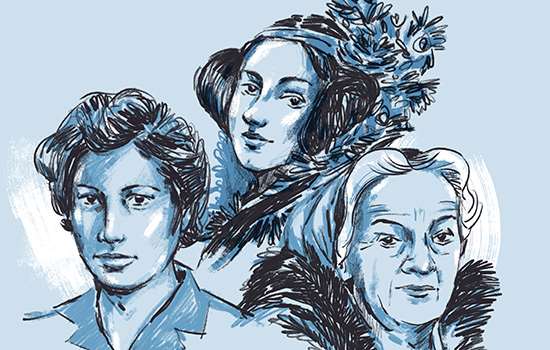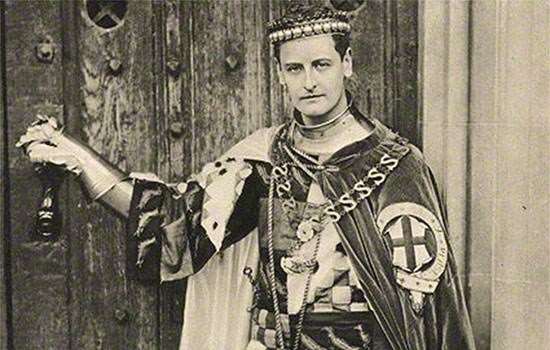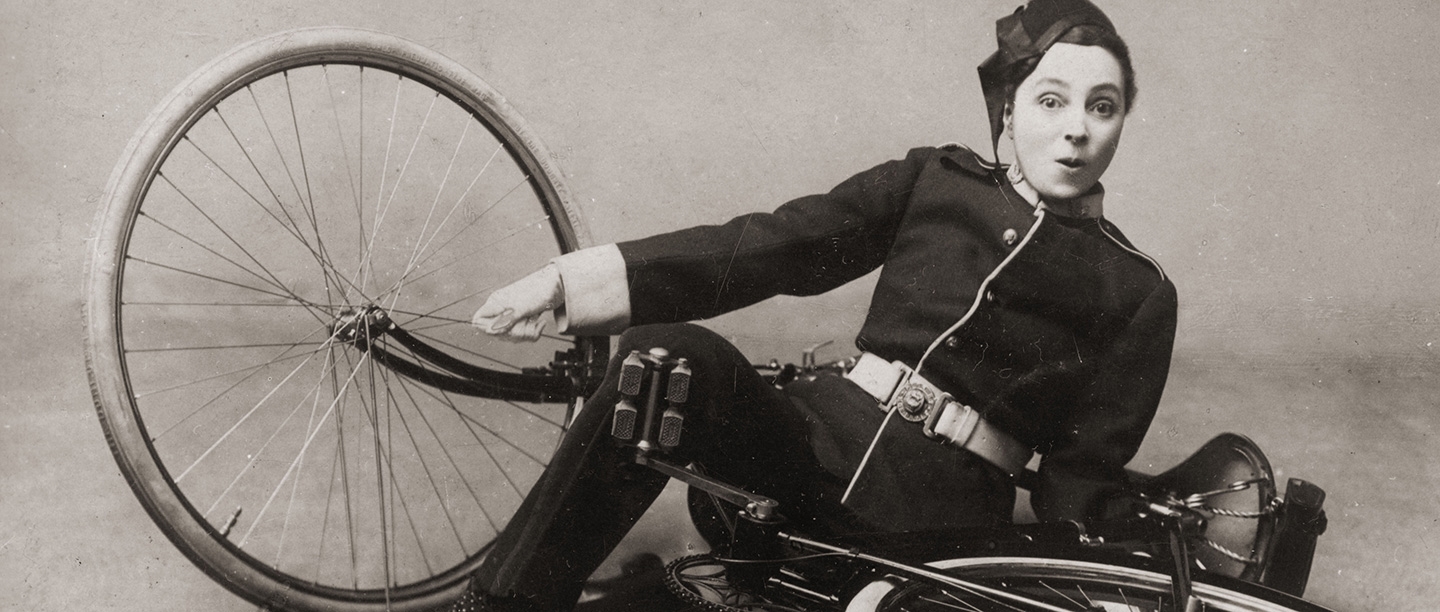CHANGING CLOTHES
In 1918 the poet and aristocrat Vita Sackville-West started to wear the breeches and gaiters of a wartime land army girl. Even her mother felt this outfit suited her height and striking good looks: ‘she looks so charming in her corduroy trousers. She ought to have been a boy!’ Many other women played with ideas of androgyny, female masculinity or gender-crossing between the wars. However their clothing choices didn’t necessarily represent lesbian or transgender identities.
Masculine styles for women had a variety of origins. Many late 19th-century ‘New Women’ wore outfits of a matching plain jacket and skirt, sometimes with a tie and an unadorned hat. The wearer hoped to show that she was of independent mind, did not seek flattery from men and was serious about her new profession, whether as social worker, writer or school teacher. Some of these women wore masculine clothing to signal their affinity for same-sex relationships, though this code was not widely recognised by the public. The ‘New Woman’ of the 19th century went on to form the backbone of the suffrage struggle of the 1910s (though in their set-piece marches suffragettes dressed in ultra-feminine clothes to make a political point) and their emancipated tailored style continued through to the 1930s.
Women’s new uniformed services in the First World War also introduced the pleasures of masculine clothing to thousands of women workers. Shocking at first, the sight of female bus conductors, auxiliary military corps and police, with their smart tunics and shiny buttons soon became familiar. They were lauded as modern women giving brave service, a positive sign of the future.
Interwar Years
After the war ended, there were varying and often contradictory ideas about women’s roles in society. The mixing up of the gender order – in women’s appearance, their attitudes to work and their wartime social authority – was increasingly seen as an aberration that should return to ‘normal’.
Nevertheless, mainstream women’s fashion of the 1920s started to borrow from men’s styles. Alongside the short-skirted, tubular look of the ‘Flapper’, a severely masculinised style was also in vogue. Women cut their hair, sometimes as short as a man’s – the Eton crop – and wore strictly tailored jackets and monocles. Even those women striving for the height of fashion wore their masculine accoutrements with a skirt, however. Trousers were only acceptable for sports (riding, hiking and sometimes tennis) and certainly not in everyday life until well after the Second World War.
These were years of change, from war to peace, from traditional gender roles towards modernity. Legislation offered women further rights in the professions and family law, while birth control became a subject of controversy. In 1928 women finally gained the vote on the same terms as men. In this context of change, magazines and newspapers stirred up alarm (as well as eliciting humour) about potential gender role reversals made manifest in clothing.
Playing with gender in theatre and music hall
Women’s adoption of masculine clothing might demonstrate serious intent and a determination to live a free life, but it could also have a playful side. This was especially easy for women in creative and artistic circles and the theatre, an accepted place for exploring different gendered personas. The actress and pageant master Gwen Lally was well known for her masculine attire both on and off stage. In her acting career in the early 20th century Lally played male Shakespearean roles, as did many other women actors. Her friendship circles included feminist women in the theatre who took a similar approach to testing and performing gender, such as the suffrage theatre director and lesbian Edith Craig and Lilian Baylis, manager of the Old Vic.
In popular theatre, too, it was common to see women in male clothing on the stage, as Principal Boys in pantomime, or as male impersonators in the music hall – an immensely popular type of act during the Edwardian years, personified by stars such as Vesta Tilley and Hetty King. Male impersonators mimicked soldiers and poked fun at the ‘swell’, the man-about-town and his smug masculinity in songs such as ‘Burlington Bertie’. Adopting a masculine sexual swagger as the swell, and parodying masculinity and class power, they delighted audiences on many levels. The music hall was a place to be playful, a licensed space to break with convention and undermine authority by crossing the boundaries of gender and class.
Read more about Gwen LallyVita Sackville-West and Virginia Woolf
When, in 1918, Vita Sackville-West adopted breeches, she had recently discovered her ‘duality’ and begun a passionate affair with her friend Violet Trefusis. On occasion, Vita completely disguised herself as a man, passing as ‘Julian’ during her months-long elopement to France with Violet. ‘The extraordinary thing was, how natural it all was for me’, she wrote. Vita returned to her marriage, separated from Violet, but continued to have affairs with women.
After she bought Sissinghurst Castle in Kent in 1930, her everyday clothing was designed for work in the garden that she made there. Her breeches, boots and jackets were more a practical choice than a public statement about her sexuality. She kept her lesbian affairs largely hidden, and wore suitably feminine dresses on public occasions.
One of Vita’s best-known love affairs was with Virginia Woolf which inspired Woolf to write her playful novel Orlando (1928), a fictionalised biography of Vita. The protagonist Orlando not only changes sex over the course of their life of 400 years, but falls in love with both women and men. ‘The change of sex, although it altered their future,’ Woolf writes of Orlando, ‘did nothing whatever to alter their identity.’ Instead, it is the change of clothes, from masculine to feminine, that Woolf suggests makes the biggest difference:
Orlando ….was becoming a little more modest, as women are, of her brains ... The change of clothes had, some philosophers will say, much to do with it…They change our view of the world, and the world’s view of us.
For Virginia Woolf, gender was flexible, subtle and complex, not a result of biology or modern categories of sexual identity but of culture and social shaping.
Lower Class women and the ‘masquerader’
Upper-class and bohemian women like Vita Sackville-West had a certain leeway to be eccentric. But so also did working-class women – mostly in the form of the popular ‘masquerader’ figure, a woman who cross-dresses or passes as a man. There was already an established place in popular culture for the working-class woman masquerader that dated back to 18th-century broadsheet ballads praising ‘female soldiers’. However in the interwar years stories of masqueraders became a particularly popular genre in the mainstream press. Ordinary women who passed as men and showed themselves to be good workers (as waiters, plumber’s mates, or shop-keepers for example) were admired for their achievement of competent and respectable masculinity. William Holton, who had passed as a man for 20 years, working as a road-mender and timber haulier until taken ill in 1929, even had a wife and baby.
Such details may have given the press stories added titillation, but passing as a working man was not presented (or mostly understood) as sexual transgression. Passing women were usually treated positively by journalists, as entertaining tricksters who’d fooled the authorities – their employers and the police – as well as their workmates and neighbours. With parallels to male impersonators on stage, they were described as looking like perfect young men. Working at several different levels of entertainment and humour, these stories upheld ideals of masculinity while at the same time also subverting and questioning them.
The reasons these masqueraders gave for passing range from the ability to earn much higher male wages, to having a lark, to even enabling them to live as ‘husband and wife’ with a dear female friend. Some said they always felt drawn to male clothing, sports and freedoms. Although it’s tempting to think of them today as lesbians, transmen or non-binary people, they wouldn’t have known these terms themselves. In their own time period they already had a social role they could fit into – the trickster masquerader, the clever young woman with few options who was trying to get ahead.
RADCLYFFE HALL AND LESBIAN IDENTITY
While masculine clothing could be both disturbing and entertaining to interwar social commentators, it was not seen as an expression of lesbian identity. Only after the 1928 prosecution and censorship of the lesbian novel The Well of Loneliness, does the masculine look begin to get linked to same-sex desire. The book’s main character is a masculine ‘invert’ – a term at the time for lesbian – who even has the male name of Stephen. Its well-known author, Radclyffe Hall, intended the novel as a plea for greater social tolerance of love between women. Hall, who used the nickname ‘John’ among her friends, was pictured in the press in short hair and fashionably severe tailored clothes. Like other wealthy women she wore breeches for country sports and dog shows.
The influence of The Well of Loneliness trial in equating masculine women and lesbianism has often been exaggerated, but coupled with the swing back to femininity in women’s fashion it did contribute to an increasing perception of female masculinity as sexual deviance. Some women who continued to present themselves this way were perceived as odd, at the very least, while others chose to publicly declare their sexual preference.
Masculine clothing was a source of empowerment for many lesbians, but it also left them vulnerable to greater social hostility by mid-century, as such attire became more closely associated with sexual as well as gender non-conformity. The period of playfulness and gender experimentation between the wars had drawn to a close, and not until the 1960s would gender and sexuality norms be challenged seriously again.
By Alison Oram, Professor of Social and Cultural History at Leeds Beckett University
Further reading
Laura Doan, Fashioning Sapphism: The Origins of a Modern English Lesbian Culture (2001)
Victoria Glendinning, Vita: The Life of V. Sackville-West (1983)
Alison Oram, Her Husband was a Woman! Women’s Gender-crossing in Modern British Popular Culture (2007)
Virginia Woolf, Orlando: A Biography (1928)
Top image: The male impersonator and actress, Vesta Tilley, in a 1910 publicity photograph (© Transcendental Graphics/Getty Images)
Explore More
-

WOMEN IN HISTORY
Read about the remarkable lives of some of the women who have left their mark on society and shaped our way of life – from Anglo-Saxon times to the 20th century.
-

LGBTQ+ History
LGBTQ+ history has often been hidden from view. Find out more about the lives of some LGBTQ+ individuals and their place in the stories of English Heritage sites.
-

Listen to the podcast
Find out more about Gwen Lally, her gender and sexuality, and her role as director of the Battle Abbey Pageant by listening to this episode of Speaking with Shadows.

